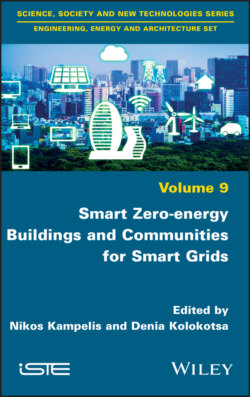Читать книгу Smart Zero-energy Buildings and Communities for Smart Grids - Группа авторов - Страница 12
1
The Role of Smart Grids in the Building Sector
ОглавлениеA smart grid is a dynamically interactive real-time infrastructure concept that encompasses the many visions of the stakeholders of diverse energy systems (El-Hawary 2014). Smart grids are electrical power grids that are more efficient and more resilient, and therefore “smarter”, than existing conventional power grids. The smartness is focused not only on the elimination of blackouts, but also on making the grid greener, more efficient, adaptable to customers’ needs, and therefore, less costly (El-Hawary 2014; Giordano et al. 2013). Smart grids incorporate innovative IT technology that allows for two-way communication between the utility and its customers/users. As a result, the sensing along the transmission lines and the sensing from the customer’s side is what makes the grid “smart”.
Like the Internet, the smart grid consists of controls, computers, automation, new technologies, smart buildings and equipment working together, but in this case these technologies will work with the electrical grid to respond digitally to the quickly changing energy demands of the users. Therefore smart grids create an exceptional opportunity for the support of the development of smart zero-energy buildings and communities, and they offer a step towards the Internet of Things (IoT) for the Energy and Building Industry (Chen et al. 2013; Zhen et al. 2012).
Smart grids open the door to new applications with far-reaching interdisciplinary impacts: providing the capacity to safely integrate more renewable energy sources (RES), smart buildings and distributed generators into the network; delivering power more efficiently and reliably through demand response and comprehensive control and monitoring capabilities; using automatic grid reconfiguration to prevent or restore outages (self-healing capabilities); enabling consumers to have greater control over their electricity consumption and to actively participate in the electricity market.
Smart grids can create a revolution in the building sector. The accumulated experience of the last few decades has shown that the hierarchical, centrally controlled grid of the 20th century is ill-suited to the needs of the 21st century. The smart grid can be considered as a modern electric power grid infrastructure for enhanced efficiency and reliability through automated control, high-power converters, modern communications infrastructure, sensing and metering technologies, and modern energy management techniques based on the optimization of demand, energy and network availability. The role of buildings in this framework is crucial. This chapter addresses critical issues related to smart grid technologies and the integration of buildings in this new power grid framework (Güngör et al. 2011). The main objective of this chapter is to provide a contemporary view of the current state of the art in the potential of buildings and communities to be integrated in smart grids, as well as to discuss the still-open research issues in this field. Since the vast majority of smart grids’ potential customers are buildings (residential, commercial, retail and industrial) and communities, the chapter addresses the challenges posed by smart grids on the building and community level.
